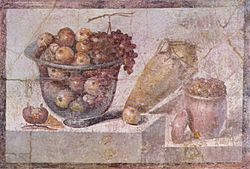Roman food
Roman food was mainly obtained from the Mediterranean area and Gaul (now France). Romans enjoyed foodstuffs from the trade networks of the Roman Republic and Empire. Keeping up the food supply to the city of Rome was a major political issue in the late Republic. It became one of the ways the emperor expressed his relationship to the Roman people.





Three meals a day was normal in ancient Rome, as today. In the morning, a breakfast called the ientaculum[2] was served at dawn. Later, around 11:00 am, Romans ate a small lunch, and in the evening, they ate the cena,[2] the main meal of the day. In the Empire period, the cena increased in size and diversity. It was now eaten in the afternoon. The vesperna,[3] a light supper in the evening, was abandoned, and a second breakfast was introduced around noon, the prandium.
In the lower strata of society, the old routine was kept: it corresponded more closely to the daily rhythms of manual labor.
Originally flat, round loaves made of emmer (a cereal related to wheat) with a bit of salt were eaten; among the upper classes, eggs, cheese, and honey, along with milk and fruit were also consumed. In the Empire period, around the beginning of the Christian era, bread made of wheat was introduced. Later, more and more wheaten foods began to replace emmer bread. Poor romans ate bread, vegetable, soup and porridge. Meat and shellfish were a luxury, unless they lived in the countryside and could go hunting or fishing.
The bread was sometimes dipped in wine and eaten with olives, cheese and grapes. They also ate wild boar, beef, sausages, pork, lamb, duck, goose, chickens, small birds and fish. Romans liked to make mealtimes fun by roasting hare with wings stuck on them to look like a flying horse.
At dinner slaves gave guests small hot bread rolls to wipe their plates clean. Roman flour contained a lot of dust and bits and this made bread so coarse that it wore down people's teeth. The wealthier Romans liked to eat snails flattened on milk, peacock's brains and flamingos tongues.
Cena
changeAmong the upper classes, who did not do manual labor, all business was done in the morning. After the prandium, a visit would be made to the baths. Around 2 p.m.,[4] the cena would begin. This meal could last until late in the night, especially if guests were invited, and would often be followed by a round of drinks.
In the period of the kings and the early republic, but also in later periods (for the working classes), the cena essentially consisted of a kind of porridge, the puls. The simplest kind would be made from emmer, water, salt and fat. The more sophisticated kind was made with olive oil, with an accompaniment of assorted vegetables when available. The richer classes ate their puls with eggs, cheese, and honey and it was also occasionally served with meat or fish.
Over the course of the Republican period, the cena developed into two courses: a main course and a dessert with fruit and seafood (e.g. molluscs, shrimp). By the end of the Republic, it was usual for the meal to be served in 3 parts: 1 course (gustatio), main course (primae mensae), and dessert (secundae mensae).
Poorer foods
changeIn contrast to the fine banquets, poor people ate the cheapest foods, so they had for breakfast grain made into twice-baked bread and porridge, and for lunch a vegetable and meat stew. The vegetables available included millet, onions, turnips, and olives with bread and oil on the side.
At dinner they had thin soup or meat with cheese, and a pudding of honey.
Roman drink
changeThe Romans mainly drank wine, the main drink of the Empire, and water. The wine could be laced with spices and honey to improve the taste. Slaves poured wine and honeyed water in flasks. Slaves filled goblets with wine from large dishes. However, drinks such as milk were considered uncivilised and hence were only used for children, medical purposes and making cheese. The wine drunk across the empire was produced in Italy, Africa, Gaul, Spain and Greece. Beer was also drunk by Romans in Britain.
Roman kitchens
changeRoman kitchens were usually small rooms, simply equipped with built-in clay ovens and wooden cupboards. A charcoal fire heated a brick hearth, where the cook fried or cooked food in earthenware or bronze pots for baking or roasting. They placed meats in the ashes. The Roman kitchens were small compared to the one we have today. The kitchen would also have large jars of olive oil, wine, vinegar and fish sauces, as well as a mortar for grinding up spices. Only richer people had kitchens, although they didn't cook because their slaves did it. Despite the simple facilities, the cooks and slaves produced spicy dishes of shellfish, wild boar, fruits and sweets.
References
change- ↑ J. Carson Webster 1938. The labors of the months in antique and mediaeval art to the end of the twelfth century, Studies in the Humanities 4 (Northwestern University Press, 1938), p. 128. In the collections of the Hermitage Museum
- ↑ 2.0 2.1 Artman, John:"Ancient Rome- Independent Learning Unit", page 26, Good Apple, 1991.
- ↑ Artman, John 1991. Ancient Rome: Independent Learning Unit, page 26, Good Apple.
- ↑ Guy, John 1998. Roman life, 8, Ticktock Publishing.